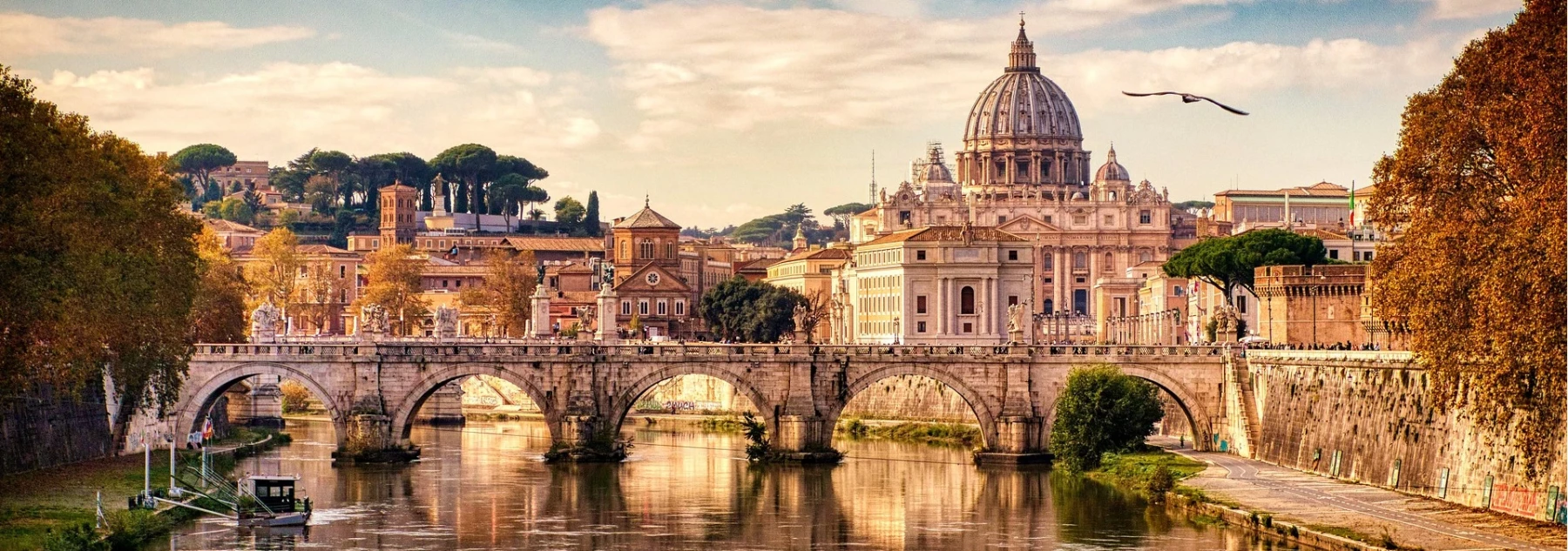To visit - Rome
Welcome to Rome, the Eternal City, where every corner breathes history, majestic architecture coexists with contemporary life, and every journey becomes a pilgrimage through the ages. Here's a description of Rome with a travel theme:
Immerse yourself in the timeless atmosphere of Rome, a metropolis where the remnants of grandeur from the past blend with the vibrancy of a modern city. With each step, you're transported through the ages, from the grand Roman monuments to the bustling streets and picturesque cafes.
The Colosseum, an iconic symbol, stands as a silent witness to gladiators and emperors, narrating epic tales of a bygone era. The ruins of the Roman Forum, with its majestic columns, unveil the ancient greatness of the Roman Republic.
Stroll through the cobblestone streets of Trastevere, where Roman authenticity shines through every colorful facade and sunlit square. The bohemian and artistic atmosphere of the neighborhood captivates travelers with its craft shops, family-run trattorias, and street art.
The timeless beauty of the Trevi Fountain attracts visitors who toss a coin into its waters, hoping for a return to Rome. The Spanish Steps provide a relaxing spot surrounded by designer boutiques and the elegance of the Dolce Vita.
The Vatican, with the majestic St. Peter's Basilica and museums housing priceless artistic treasures, offers a unique spiritual and cultural experience. The Sistine Chapel, adorned with Michelangelo's frescoes, inspires silent contemplation in the face of such artistic genius.
Rome's bustling streets are the stage for an exciting daily life. Local markets overflow with Mediterranean flavors, while trattorias invite you to savor deliciously simple dishes, accompanied by fine Italian wines.
Whether atop Palatine Hill at sunset over the Tiber River or wandering the charming alleys of the Monti district, Rome unveils its treasures to those who dare to venture into its historically rich streets. It's a city that transcends time, a travel experience where every moment becomes a page in eternity.
The 13 essential things to do in Rome :
Summary
- To visit
-
- 1 - The Coliseum
- 2 - Saint Peter's Square
- 3 - Saint Peter's basilica
- 4 - The Vatican Museums
- 5 - The Roman Forum and the Palatine
- 6 - Capitol
- 7 - Trevi Fountain
- 8 - The Baths of Caracalla
- 9 - Piazza Navona
- 10 - The Pantheon of Rome
- 11 - The Ponte Sant’Angelo and the Castle Sant’Angelo
- 12 - Villa Borghese
- 13 - The Palatine Hill
- Rome - Where to Stay?
- Rome - How to get around?
- Rome - Best period
1 - The Coliseum
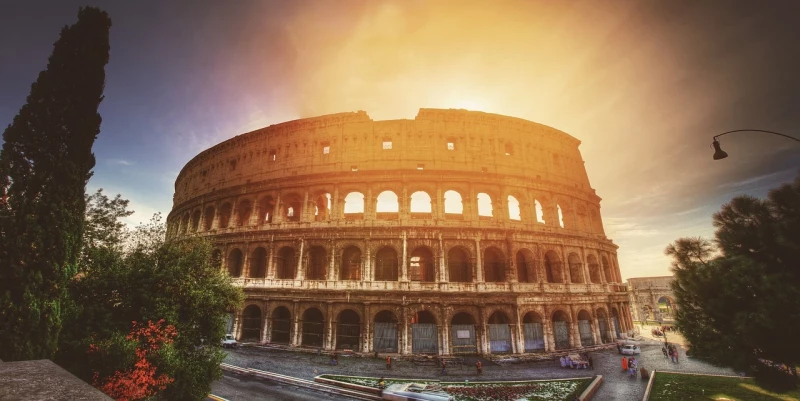
The Colosseum, an iconic symbol of Rome, stands majestically as an imposing witness to imperial history in the heart of the ancient capital. At every corner of its arches, the Colosseum tells the epic tales of fearless gladiators, chariot battles, and grand spectacles that captivated the imagination of generations.
This impressive amphitheater, built in the 1st century AD, embodies Roman architectural grandeur. Visitors are transported through time as they stroll through its corridors, feeling the echoes of cheers that once reverberated within these stone walls. The stands, once filled with thousands of spectators, offer a breathtaking view of the arena, revealing the technical ingenuity of the era.
At sunrise or sunset, the Colosseum is bathed in golden hues, creating a magical backdrop that invites contemplation. Illuminated by spotlights, it becomes the stage for a unique visual experience, where ancient history seamlessly intertwines with the timeless charm of the Eternal City.
Standing at the crossroads of the past and present, the Colosseum stands as an absolute must-visit for travelers seeking historical adventures. Each stone tells a story, each arch celebrates the grandeur of ancient Rome, making the Colosseum a captivating symbol of the extraordinary cultural heritage of this fascinating city.
 Our tips for getting the most out of your experience.
Our tips for getting the most out of your experience.
Visiting the Colosseum can be an unforgettable experience, but to make the most of your visit, here are some helpful tips:
-
Buy Tickets in Advance: Avoid long queues by purchasing your tickets online in advance. This also allows you to choose specific time slots.
-
Consider a Guided Tour: Think about joining a guided tour to gain in-depth insights into the history of the Colosseum. Guides can provide fascinating details you might otherwise miss.
-
Arrive Early in the Morning: If possible, plan your visit early in the morning to avoid crowds. This allows you to enjoy the site in a quieter atmosphere.
-
Avoid Peak Periods: Summer months and school holidays can be very crowded. If possible, plan your visit during quieter periods for a more pleasant experience.
-
Wear Comfortable Shoes: Exploring the Colosseum involves a lot of walking, so make sure to wear comfortable shoes to navigate the stands and corridors.
-
Bring Water and Sunscreen: Rome can be hot, especially in summer. Ensure you bring water to stay hydrated and sunscreen to protect yourself from the sun.
-
Explore the Upper Levels: Some tours only include the lower levels, but access to the upper levels offers an exceptional panoramic view of the Colosseum and Rome. Make sure to check if your ticket includes this option.
-
Take Time to Soak in the Atmosphere: Sit on the stands, envision the spectacles that once took place here, and appreciate the incredible history surrounding this structure.
-
Check Out the Exhibitions Inside: The Colosseum also hosts interesting exhibitions. Take the time to explore these exhibits to deepen your understanding of the site's history.
-
Capture the Moment: Don't forget your camera to capture memories of this memorable visit. The views from the Colosseum provide excellent photographic opportunities.
By following these tips, you'll be better prepared to make the most of your visit to the Colosseum and turn it into a rewarding experience.
2 - Saint Peter's Square
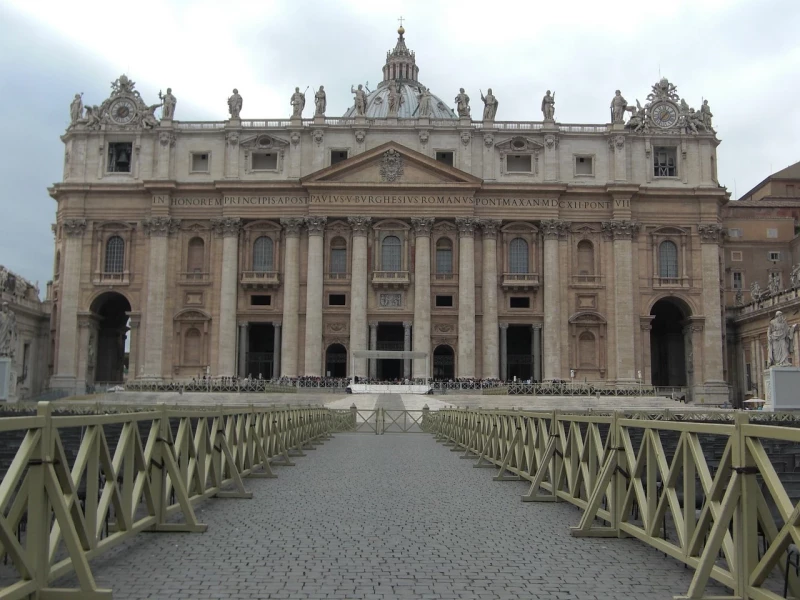
St. Peter's Square, nestled at the heart of the Vatican City, stands as a majestic and spiritual gem, drawing pilgrims from around the world and captivating travelers with its architectural grandeur. Surrounded by the magnificence of St. Peter's Basilica and the iconic colonnades designed by Gian Lorenzo Bernini, this square is more than just a public space it is a place where art, faith, and history seamlessly converge.
At the center of the square, an Egyptian obelisk, a testament to centuries gone by, reaches skyward, adding an element of mystery and magnificence to the panorama. The welcoming embrace of the two sweeping arms of the colonnades extending from the basilica creates an enveloping atmosphere, as if the square itself were a warm embrace extended to visitors.
The square takes on a special aura at different times of the day. In the early morning, the first rays of sunlight illuminate the facade of the basilica with a golden glow, while dusk transforms the area into a peaceful sanctuary, bathed in soft light. In the evening, the square comes alive with the brilliance of lights, creating a magical ambiance.
Visitors can immerse themselves in spirituality by observing the semi-circular colonnade that seems to embrace the square, creating a sense of unity and communion. The monumental fountain at the center of the square provides a refreshing pause, adding a touch of melody to the constant hum of conversations and footsteps.
St. Peter's Square is not merely a passageway; it is also a focal point for gathering, whether for faithful attending a papal audience or for travelers capturing the moment on their cameras. Every corner of this square attests to the grandeur of art, faith, and culture, making a visit to this place an unforgettable experience for any traveler in search of beauty and spirituality.
 Our tips for getting the most out of your experience.
Our tips for getting the most out of your experience.
Visiting St. Peter's Square can be an extraordinary experience, but to make the most of it, here are some helpful tips:
-
Arrive Early in the Morning: To avoid crowds, plan your visit early in the morning. It's a prime time to enjoy the beauty of the square before the arrival of massive crowds.
-
Check the Event Calendar: See if any special events, such as a papal audience, are scheduled during your visit. This can impact the crowd and accessibility to certain areas.
-
Book a Guided Tour: Opt for a guided tour to gain in-depth insights into the square and its surroundings. Guides can share interesting anecdotes and help you bypass queues.
-
Climb St. Peter's Basilica Dome: Take advantage of an exceptional panoramic view of the square and the city of Rome by climbing to the dome of the basilica. Make sure to check the opening hours.
-
Respect the Dress Code: If you plan to visit the interior of the basilica, ensure you adhere to the appropriate dress code, covering shoulders and knees.
-
Bring Water and Snacks: Walking around the square can be tiring. Ensure you have water and snacks to stay hydrated and energized.
-
Take Time to Sit: Find a bench on the square, relax, and people-watch. It's an ideal spot to soak in the unique atmosphere of the Vatican City.
-
Explore the Surroundings: Don't limit your visit to the square alone. Explore the surroundings of the Vatican City, including Via della Conciliazione and the Vatican Gardens.
-
Be Mindful of Street Vendors: Be aware of street vendors who may approach you with souvenirs. If you're not interested, be polite but firm.
-
Enjoy Quiet Moments: After sunset, the square takes on a special atmosphere. Take advantage of this quieter time to appreciate the beauty of the place.
By following these tips, you'll be better prepared to appreciate the splendor of St. Peter's Square and make it a memorable experience.
3 - Saint Peter's basilica
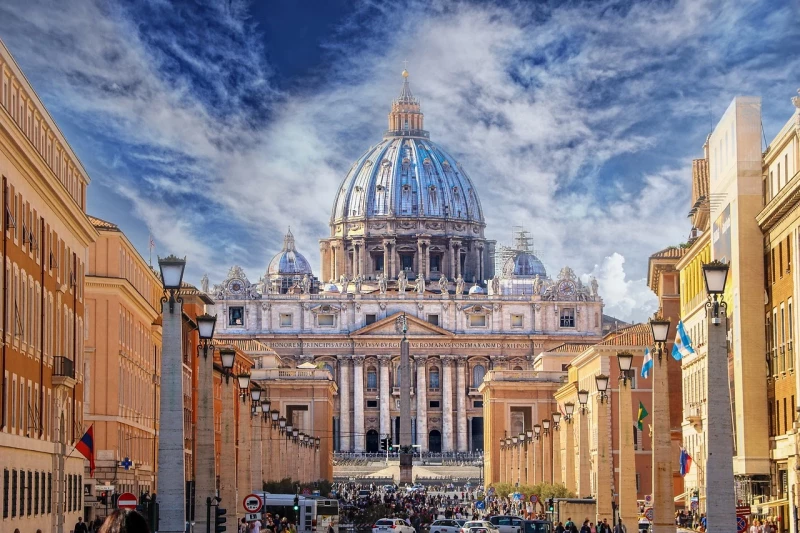
St. Peter's Basilica, nestled at the heart of the Vatican City, stands majestically as a dazzling architectural masterpiece, inviting travelers on a journey through time, faith, and extraordinary artistic craftsmanship.
The majestic colonnades surrounding St. Peter's Square seem to embrace the basilica, creating a theatrical scene even before one enters. The statues adorning the facade bear witness to the rich history of Christianity, while the imposing dome rises towards the sky, serving as a constant reminder of divine grandeur.
Inside, St. Peter's Basilica reveals a breathtaking blend of marble, gilding, and frescoes. The exquisite details of sculptures by Michelangelo, Bernini, and other Renaissance masters captivate the eye, creating a visual symphony that celebrates art and spirituality.
Visitors can wander through the vast spaces of the basilica, gaze upon Michelangelo's Pietà, admire the richly decorated side chapels, and climb to the dome for an exceptional panoramic view of the Vatican City and Rome.
The solemn and spiritually charged atmosphere of St. Peter's Basilica makes it a pilgrimage site for believers worldwide. For travelers, it is a place of contemplation, where art, history, and faith converge to create an unforgettable experience at the heart of one of the world's most sacred destinations.
Whether one is a believer or an art enthusiast, St. Peter's Basilica offers an immersion into the exceptional cultural and spiritual heritage of humanity, turning each visit into a journey beyond the boundaries of time and into profound contemplation.
 Our tips for getting the most out of your experience.
Our tips for getting the most out of your experience.
Visiting St. Peter's Basilica can be a captivating experience, but to make the most of it, here are some practical tips:
-
Arrive Early in the Morning: To avoid long queues, plan your visit early in the morning. This is often the quietest time of the day.
-
Wear Appropriate Clothing: Make sure to adhere to the basilica's dress code. Avoid shorts, short skirts, and bare shoulders, especially if you plan to visit the interior.
-
Book a Guided Tour: Opt for a guided tour to gain in-depth insights into the history, art, and architecture of the basilica. Guides can also help you navigate through the crowds.
-
Climb to the Dome: If your physical condition allows, consider climbing to the dome for a spectacular view of the Vatican City and Rome. Note that this involves climbing a considerable number of stairs.
-
Visit the Grottoes and Necropolis: Explore the grottoes beneath the basilica, where many popes are laid to rest, and consider booking a tour of the necropolis for an even more immersive experience.
-
Avoid Peak Times: The basilica is often more crowded in the afternoon. If possible, plan your visit during off-peak hours or on weekdays.
-
Take Time to Admire the Details: The basilica is filled with artistic details. Take the time to admire the sculptures, mosaics, and artworks that make this place an artistic treasure.
-
Attend a Mass or Ceremony: If it aligns with your interests, attend a Mass or ceremony at the basilica for a unique spiritual experience.
-
Be Prepared for Security: Be ready to go through security checks at the entrance of the basilica. Avoid carrying prohibited items, such as knives or sharp objects.
-
Maintain Respectful Behavior: Maintain respectful behavior towards the holy site and fellow visitors. St. Peter's Basilica is a place of worship for many people.
By following these tips, you will maximize your experience when visiting St. Peter's Basilica and fully appreciate the beauty and spirituality of this iconic site.
4 - The Vatican Museums
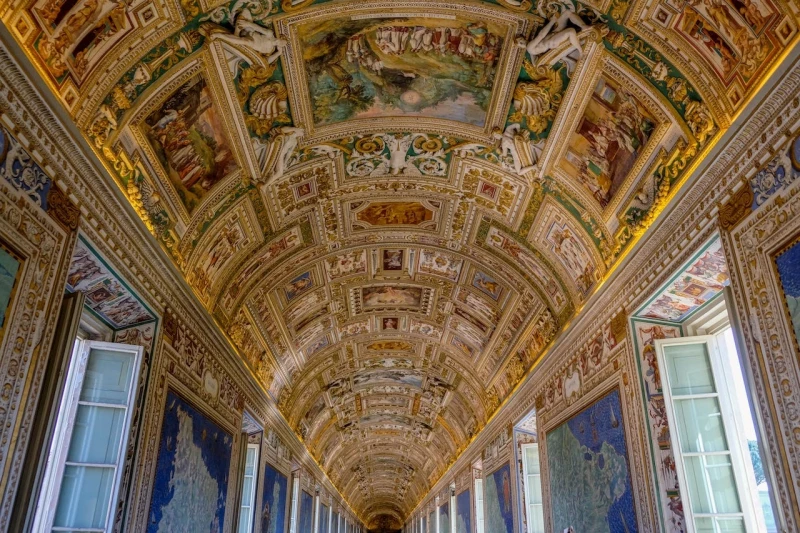
The Vatican Museums constitute an extraordinary artistic and cultural treasure that captivates travelers worldwide with its immense richness in art, history, and architecture.
Nestled at the heart of the Vatican City, the Vatican Museums offer a fascinating immersion into centuries of human creativity. Visitors are welcomed into sumptuous galleries adorned with frescoes, sculptures, and artworks by masters such as Michelangelo, Raphael, and Leonardo da Vinci.
The undeniable icon of the museums is the Sistine Chapel, an artistic marvel where Michelangelo's masterful frescoes, including the famous Last Judgment, transform the ceiling into a celestial tableau of striking beauty. Visitors can feel the palpable emotion of being immersed in art at its highest level.
The Raphael Rooms, a lesser-known yet equally extraordinary treasure, enchant with the grace of Raphael's works and those of his disciples. The corridors of the Vatican Museums lead to hidden gems like the Gallery of Maps, providing a visual exploration of Italy through decorative maps from the 16th century.
The exterior of the museums is not to be overlooked, with picturesque gardens and inner courtyards offering moments of tranquility and reflection amidst the artistic wealth.
However, the popularity of the museums can lead to significant crowds. To make the most of your visit, consider purchasing tickets in advance, exploring less crowded sections during off-peak hours, and if possible, joining a guided tour for an in-depth perspective.
The Vatican Museums offer an unforgettable travel experience where art and culture converge to create a journey through the history of humanity, capturing the imagination of those fortunate enough to explore them.
 Our tips for getting the most out of your experience.
Our tips for getting the most out of your experience.
Visiting the Vatican Museums can be a rewarding experience, but due to their popularity, it's wise to plan your visit carefully. Here are some tips to make the most of your exploration:
-
Purchase Tickets Online in Advance: Avoid long queues by buying your tickets online in advance. This will save you time and allow for a quicker entrance to the museums.
-
Opt for a Guided Tour: A guided tour can provide in-depth information about the artworks and highlights of the museums. Some tours also offer skip-the-line options.
-
Visit Early Morning or Late Afternoon: Museums are generally less crowded early in the morning or late in the afternoon. Try to plan your visit during these times to avoid crowds.
-
Explore Lesser-Known Sections: Lesser-known sections of the museums may be less crowded. Take advantage of the opportunity to explore these areas more peacefully.
-
Focus on the Highlights: The Vatican Museums are vast, so it's helpful to plan in advance which artworks you want to prioritize. The Sistine Chapel, Raphael's Rooms, and the Gallery of Maps are among the must-see attractions.
-
Respect the Dress Code: Make sure to adhere to the museums' dress code, avoiding shorts, bare shoulders, and short skirts, especially if you plan to visit St. Peter's Basilica afterward.
-
Take a Break in the Vatican Gardens: The Vatican Gardens provide a tranquil retreat. If weather permits, take a break to relax and enjoy the peaceful surroundings.
-
Bring Water and Snacks: Museums can be extensive, so be sure to bring water to stay hydrated and snacks to refuel.
-
Pay Attention to Signs: Follow signs and directions to avoid getting lost. The museums have well-marked routes to make your visit more straightforward.
-
Enjoy the Panoramic View from the Dome: If you have the time and energy, climb to the dome of St. Peter's Basilica for an exceptional panoramic view of the Vatican City.
By following these tips, you'll be better prepared to appreciate the Vatican Museums without being overwhelmed by crowds while exploring the artistic treasures they hold.
5 - The Roman Forum and the Palatine
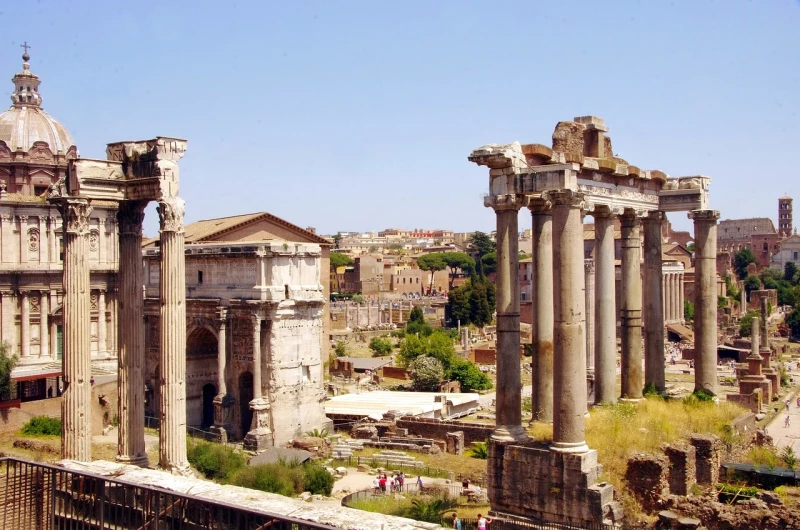
The Roman Forum and the Palatine Hill, nestled in the heart of Rome, constitute an extraordinary historical and archaeological ensemble that transports travelers through the temporal layers of ancient Rome. This immersion into the past offers a travel experience rich in discoveries, mysteries, and beauty.
The Roman Forum:
The Roman Forum, once the vibrant heart of Roman public life, unfolds today as a fascinating site of ruins and remnants. Majestic columns, imposing triumphal arches, and fragments of temples bear witness to the ancient grandeur of this space, where religious ceremonies, political speeches, and social events unfolded.
Travelers can wander among the ruins of the Basilica Julia, envision the hustle and bustle along the Via Sacra, and contemplate the Arch of Titus, a symbol of military victory. Each stone tells a story, providing a striking immersion into the daily life of ancient Rome.
The Palatine Hill:
The Palatine Hill, the mythical hill of Rome, overlooks the Forum and offers panoramic views of the city. It is the legendary cradle of Rome, where the she-wolf is said to have nursed Romulus and Remus, the legendary founders of the city. Today, the imperial ruins of the Palatine bear witness to the grandeur of imperial residences.
Lush gardens, sunlit terraces, and remnants of imperial palaces offer travelers a tranquil getaway amidst history. The ancient hunting lodges and imperial residences reveal opulence and refinement that captivate the imagination.
The visit to the Roman Forum and the Palatine Hill offers an immersive dive into Rome's history, providing travelers with an unforgettable experience at the heart of the ancient capital of the Roman Empire.
 Our tips for getting the most out of your experience.
Our tips for getting the most out of your experience.
Visiting the Roman Forum and the Palatine Hill can be an awe-inspiring journey into ancient Rome's history. Here are some tips to make the most of your visit:
For the Roman Forum:
-
Buy a combined ticket: Purchase a combined ticket that includes access to the Roman Forum and the Palatine Hill. This will save you time and money.
-
Start early in the day: Visit the Roman Forum early in the morning to avoid the midday crowds and enjoy a more serene atmosphere.
-
Use an audio guide or hire a guide: An audio guide or a knowledgeable guide can provide valuable insights into the historical significance of the various structures within the Roman Forum.
-
Prioritize must-see sites: Identify key sites such as the Arch of Titus, the Temple of Saturn, and the Basilica Julia. Allocate more time to these areas to fully appreciate their historical importance.
-
Take breaks in shaded areas: The Roman Forum can be exposed to the sun, so take breaks in shaded spots to stay refreshed, especially during warmer months.
For the Palatine Hill:
-
Continue early or later in the day: After the Roman Forum, continue your visit to the Palatine Hill. Early morning or late afternoon visits provide a more comfortable experience.
-
Explore less crowded areas: Venture to less crowded areas of the Palatine Hill, where you can enjoy the stunning views and ancient ruins in a more peaceful setting.
-
Capture panoramic photos: Take advantage of the elevated position of the Palatine Hill to capture panoramic photos of the Roman Forum, Circus Maximus, and the city of Rome.
-
Immerse yourself in the gardens: The Palatine Hill features beautiful gardens. Take some time to explore these serene green spaces and enjoy a moment of tranquility.
-
Learn about imperial residences: Delve into the history of the imperial residences on the Palatine Hill. The House of Augustus and the House of Livia offer a glimpse into ancient Roman domestic life.
General Tips:
-
Wear comfortable shoes: Both the Roman Forum and the Palatine Hill involve walking on uneven surfaces. Comfortable shoes will make your exploration more enjoyable.
-
Stay hydrated: Bring a water bottle to stay hydrated, especially during warmer months, as there might not be many drinking fountains available.
-
Check for special events: Be aware of any special events or closures that might affect your visit, such as ceremonies or maintenance work.
By following these tips, you'll be well-prepared to immerse yourself in the fascinating history of the Roman Forum and the Palatine Hill while making the most of your time at these iconic sites.
6 - Capitol
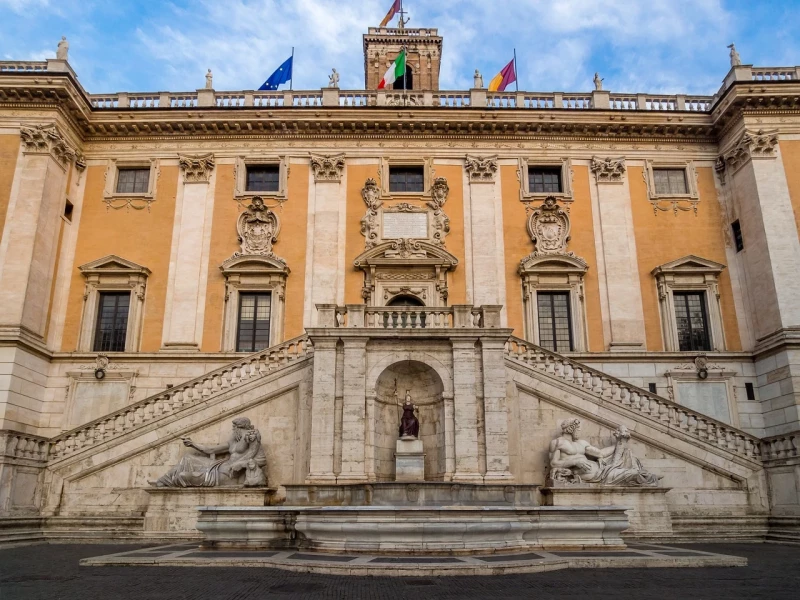
The Capitoline Hill, located at the heart of Rome, is more than just a hill; it is a powerful symbol of ancient Rome's history and power. This hill, also known as the Capitoline Hill, offers an immersive travel experience, blending impressive architecture, museums rich in artistic treasures, and a majestic square.
Piazza del Campidoglio:
Designed by Michelangelo, the Piazza del Campidoglio welcomes visitors with timeless elegance. Fan-shaped cobblestones converge toward the equestrian statue of Marcus Aurelius at the center, while the facades of the palaces, also designed by Michelangelo, house the Capitoline Museums.
Capitoline Museums:
The Capitoline Museums host an impressive collection of art and antiquities. Among the masterpieces are the famous equestrian statue of Emperor Marcus Aurelius, the Capitoline Wolf depicting the she-wolf nursing Romulus and Remus, and works by Renaissance masters.
Palazzo dei Conservatori and Palazzo Senatorio:
The adjacent Palazzo dei Conservatori and Palazzo Senatorio add a majestic touch to the hill. Their sumptuous interiors house lavishly decorated rooms and captivating exhibitions.
Altare della Patria (Monument to Victor Emmanuel II):
Not far from the Capitoline Hill stands the Altare della Patria, an imposing monument dedicated to Victor Emmanuel II, the first king of unified Italy. The view from this monument offers a spectacular panorama of the city of Rome.
The Capitoline Hill offers a comprehensive immersion into the history and grandeur of Rome, blending iconic architecture, exceptional art, and panoramic views. It is a must-visit for any traveler seeking the essence of this eternal city.
 Our tips for getting the most out of your experience.
Our tips for getting the most out of your experience.
Visiting the Capitoline Hill in Rome can be a captivating experience, and to make the most of it, here are some practical tips:
-
Start at Piazza del Campidoglio: Begin your visit at Piazza del Campidoglio, designed by Michelangelo. Admire the geometric layout and the equestrian statue of Marcus Aurelius at the center.
-
Explore the Capitoline Museums: Don't miss the Capitoline Museums, which house a rich collection of artworks and antiquities. Plan your visit based on your artistic interests.
-
Climb to Altare della Patria: Climb up to Altare della Patria for a breathtaking view of the city of Rome. It's an ideal opportunity for memorable panoramic photos.
-
Discover the Two Palaces: Explore the two adjacent palaces, Palazzo dei Conservatori and Palazzo Senatorio, to appreciate the majestic architecture and discover the exhibitions.
-
Familiarize Yourself with the History: Before your visit, read about the history of the Capitoline Hill to better understand its significance in the context of ancient Rome and modern Italy.
-
Join a Guided Tour: A guided tour can enhance your experience by providing contextual information and historical details.
-
Visit Early Morning or Late Afternoon: To avoid crowds, plan your visit early in the morning or late in the afternoon. This allows you to better appreciate the peaceful atmosphere of the site.
-
Enjoy Local Restaurants and Cafés: Explore local restaurants and cafés around the Capitoline Hill to taste Italian cuisine and enjoy a refreshing break.
-
Check for Special Events: Check the calendar for special events that might take place on Piazza del Campidoglio or in the vicinity of the Capitoline Hill during your visit.
-
Respect Site Rules: Be aware of site rules, including safety and preservation rules, and adhere to them during your visit.
By following these tips, you'll be able to fully enjoy your visit to the Capitoline Hill in Rome, exploring its history, art, and architecture in a more enriching manner.
7 - Trevi Fountain
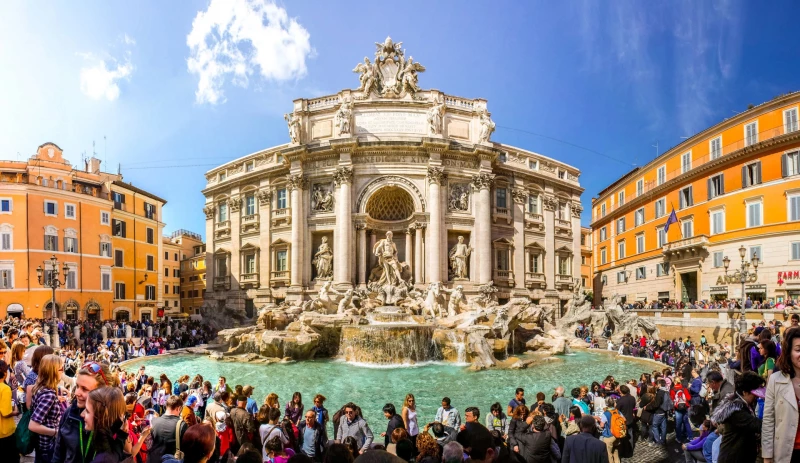
The Trevi Fountain, located at the heart of Rome, is more than just a fountain; it is an iconic work of art that embodies Baroque elegance and the magic of the Eternal City. This must-see in Rome offers an enchanting experience, blending spectacular architecture, romantic legends, and a lively atmosphere.
Features of the Trevi Fountain:
-
Baroque Grandeur: The Trevi Fountain is a Baroque masterpiece designed by architect Nicola Salvi. Its opulent and theatrical style encapsulates the splendor of 18th-century Baroque art.
-
Sculptural Marvels: The fountain's sculptures depict mythological figures, including Neptune, the god of the sea, surrounded by Tritons and seahorses. Each artistic detail contributes to the extraordinary aesthetic of the ensemble.
-
Coin Tossing Ritual: According to tradition, tossing a coin over your right shoulder into the fountain ensures a return to Rome. Tossing two coins may lead to a romance with a Roman, and three coins to marriage.
The Trevi Fountain is more than a tourist attraction; it represents a symbol of beauty, romance, and tradition, adding a magical touch to your exploration of Rome.
 Our tips for getting the most out of your experience.
Our tips for getting the most out of your experience.
Visiting the Trevi Fountain in Rome is a magical experience, and here are some tips to make the most of your visit:
-
Visit Early in the Morning or Late Evening: To avoid large crowds, plan your visit to the Trevi Fountain early in the morning or late in the evening. The subdued lighting during the evening can add to the enchanting atmosphere.
-
Throw a Coin Over Your Right Shoulder: Participate in the tradition of tossing a coin into the fountain over your right shoulder. This is believed to ensure your return to Rome. Consider tossing two coins for a chance at romance with a Roman, and three coins for marriage.
-
Appreciate the Baroque Architecture: Take a moment to admire the intricate details of the Baroque architecture and the mythological sculptures that adorn the fountain. Consider learning about the fountain's history before your visit.
-
Capture the Moment with Photos: The Trevi Fountain is a picturesque location, so be sure to capture the moment with photos. Consider visiting during different times of the day to get varied lighting.
-
Explore the Surrounding Area: The Trevi Fountain is located in a charming area with narrow streets, cafes, and gelaterias. Take some time to explore the surrounding neighborhood, perhaps enjoying some authentic Italian gelato.
-
Stay Vigilant of Pickpockets: Like many popular tourist attractions, the Trevi Fountain can attract pickpockets. Stay vigilant, keep an eye on your belongings, and be cautious in crowded areas.
-
Visit During Off-Peak Seasons: If possible, plan your visit during the off-peak seasons to enjoy a more relaxed atmosphere. Spring and fall are often considered ideal times to visit Rome.
-
Combine with Nearby Attractions: The Trevi Fountain is conveniently located near other iconic attractions like the Pantheon and the Spanish Steps. Consider combining your visit with nearby landmarks.
-
Enjoy a Meal at a Nearby Trattoria: Experience Roman cuisine by dining at a nearby trattoria. The area offers a variety of restaurants where you can enjoy a delicious meal.
-
Use Public Transportation: Consider using public transportation to reach the Trevi Fountain, as parking can be challenging in the historic city center.
By following these tips, you'll enhance your experience at the Trevi Fountain, turning it into a memorable highlight of your visit to Rome.
8 - The Baths of Caracalla
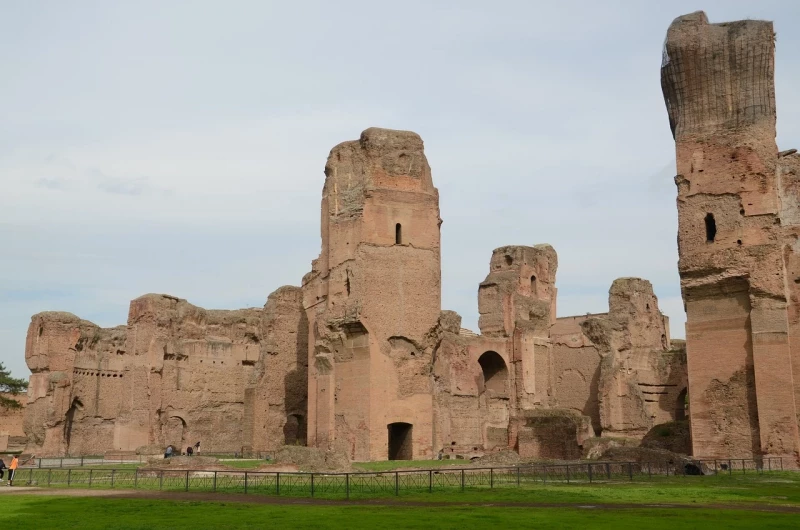
The Baths of Caracalla in Rome stand as an architectural marvel, transporting visitors to the splendor of the Roman Empire. Constructed in the 3rd century during the reign of Emperor Caracalla, these impressive baths were a luxurious public bathing complex. Now in ruins, they reveal the ingenuity of Roman engineering with their vast spaces, towering columns, and lavishly decorated rooms.
The Baths of Caracalla were more than just a bathing facility; they housed gyms, libraries, and gardens. Today, the grand atmosphere and monumental size of the ruins provide a glimpse into the level of sophistication achieved in the daily life of ancient Rome.
Visitors can stroll through the extensive ruins, envisioning ancient Romans relaxing in the hot baths, socializing in reading rooms, and indulging in recreational spaces. The imposing architecture and artistic details bear witness to the past grandeur of this structure.
Surrounded by well-maintained gardens, the Baths of Caracalla offer an immersive experience, combining imperial history with the beauty of nature. For history and architecture enthusiasts, a visit to these remarkable baths is a true journey through time, providing insight into the splendor of ancient Rome.
 Our tips for getting the most out of your experience.
Our tips for getting the most out of your experience.
Tips for Visiting the Baths of Caracalla:
-
Opt for a Guided Tour: A guided tour can provide in-depth historical and contextual information, enhancing your understanding of the Baths of Caracalla.
-
Be Prepared to Walk: The Baths of Caracalla cover a vast area, so ensure you wear comfortable shoes for exploring the extensive ruins.
-
Enjoy the Gardens: The surrounding gardens are beautiful. Take the time to stroll among the ruins and enjoy the peaceful atmosphere.
-
Bring Water and Snacks: Make sure to have water, especially in warm weather, and some snacks to stay energized during your visit.
-
Visit Early Morning or Late Evening: To avoid crowds and experience a quieter ambiance, plan your visit early in the morning or late in the evening.
-
Take Time to Observe Details: The Baths of Caracalla are rich in architectural and artistic details. Take the time to observe the sculptures, columns, and other decorative elements.
-
Imagine Ancient Life: While walking through the ruins, imagine the daily life of ancient Romans who frequented these baths. This will add an immersive dimension to your visit.
-
Check the Cultural Program: The Baths of Caracalla sometimes host cultural events. Check the local program to see if there are concerts or performances during your visit.
-
Bring a Guidebook or Use an App: A printed guidebook or a mobile app on the Baths of Caracalla can be useful to get additional information during your visit.
-
Capture Photos at Sunset: If possible, plan your visit to capture photos at sunset. The ruins take on a golden hue, creating a particularly magical atmosphere.
By following these tips, your visit to the Baths of Caracalla will not only be informative but also memorable, allowing you to fully appreciate the history and grandeur of this ancient site.
9 - Piazza Navona
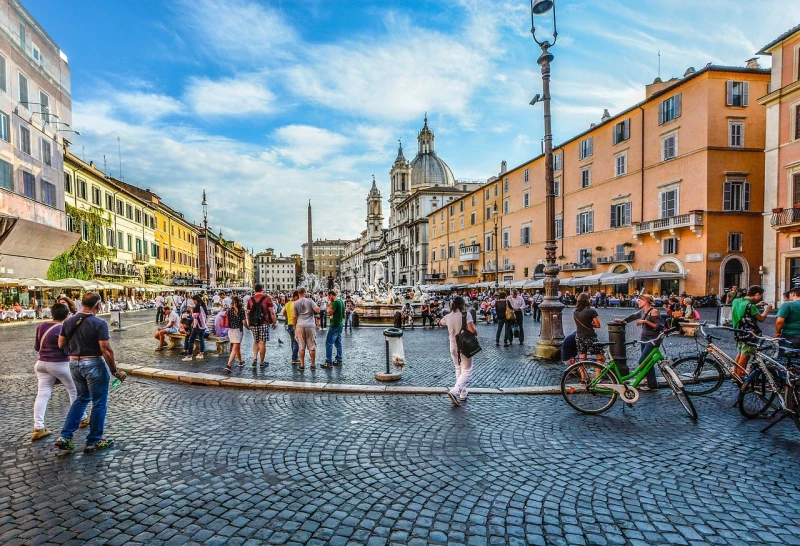
Piazza Navona, situated at the heart of Rome, is a captivating square that exudes history, architectural beauty, and the lively essence of the city. Surrounded by impeccably preserved Baroque structures, the square stands as a brilliant showcase of artistic brilliance, notably the work of Gian Lorenzo Bernini.
Key Elements of Piazza Navona:
-
Impressive Fountains: At the square's center lies the Fountain of the Four Rivers, a creation by Bernini, symbolizing the four great rivers from different corners of the world. Another fountain, the Fountain of Neptune, contributes to the overall aquatic grandeur.
-
Architectural Richness: The facades of the neighboring buildings weave a narrative of Roman Baroque art. The Palazzo Pamphilj and the church of Sant'Agnese in Agone play their part in enhancing the square's majestic ambiance.
-
Vibrant Atmosphere: Piazza Navona boasts a dynamic atmosphere, complete with street performers, charming cafes, and street vendors. It serves as an ideal location to immerse oneself in the daily rhythm of Roman life.
-
Cultural Engagements: The square occasionally hosts cultural affairs, art exhibitions, and open-air performances. It's worth checking the local calendar for any festivities coinciding with your visit.
Piazza Navona encapsulates the vivacious spirit of Rome, seamlessly blending art, history, and the pulse of everyday existence in a visually and culturally enchanting composition.
 Our tips for getting the most out of your experience.
Our tips for getting the most out of your experience.
Tips for Visiting Piazza Navona:
-
Explore Early Morning or Evening: To avoid crowds, plan your visit early in the morning or late in the evening. It's also an ideal time to capture beautiful photos of the square.
-
Admire the Fountains: Take the time to admire the iconic fountains of the square, especially the Fountain of the Four Rivers in the center. The artistic details of these works are remarkable.
-
Discover Street Performers: Piazza Navona is often lively with street performers. Take the time to appreciate their varied performances, whether it's music, painting, or sculptures.
-
Visit Historical Buildings: Explore the buildings surrounding the square, such as the Palazzo Pamphilj. Some of them offer panoramic views of Piazza Navona from their terraces.
-
Indulge in Italian Gelato: The cafes and gelato stands around the square offer Italian delights. Enjoy a break to savor some gelato and soak in the atmosphere.
-
Stroll Through Surrounding Alleys: The alleys branching off from Piazza Navona lead to charming discoveries. Explore the nearby streets to find local shops and trattorias.
-
Participate in Cultural Events: Check the local calendar to see if there are cultural events, craft markets, or festivals scheduled during your stay.
-
Capture the Atmosphere at Dusk: Piazza Navona takes on a special atmosphere at sunset. Stay a bit later to capture the beauty of the square as the lights come on.
-
Prepare for Terrace Prices: If you choose to sit at one of the terraces for coffee or a meal, note that prices may be higher due to the central location.
-
Respect History and Environment: Keep in mind that Piazza Navona is a historical site. Respect the environment, avoid climbing on the fountains, and appreciate this exceptional place.
By following these tips, your visit to Piazza Navona will be rewarding, allowing you to fully appreciate its artistic charm, rich history, and lively atmosphere.
10 - The Pantheon of Rome
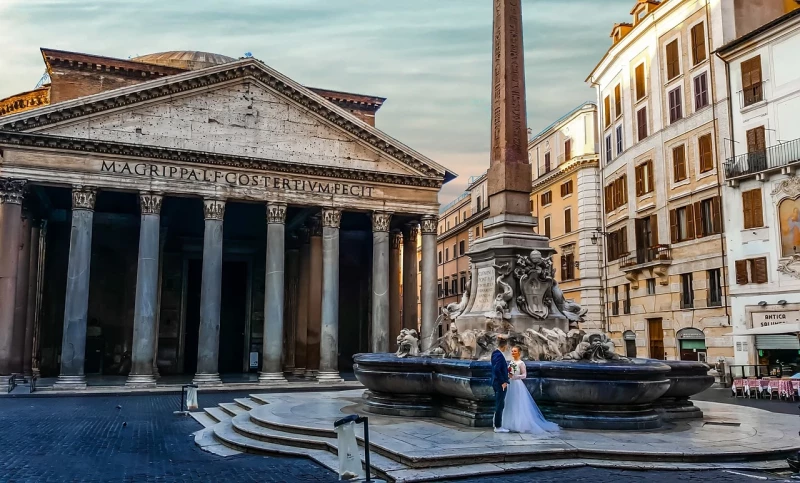
The Pantheon in Rome, an iconic architectural masterpiece, is a wonder that transcends epochs. Originally constructed by Agrippa in the 1st century BCE, the current structure, dating back to the reign of Emperor Hadrian in the 2nd century CE, stands as a testament to engineering and aesthetic brilliance.
Features of the Pantheon:
-
Impressive Dome: The Pantheon's dome, with its open oculus at the top, provides heavenly light that bathes the interior. It stands as one of the largest unreinforced concrete domes in the world.
-
Classical Architecture: The Pantheon is a perfect example of Roman classical architecture, featuring a majestic portico, imposing Corinthian columns, and a marble façade.
-
Imposing Interior: The interior of the Pantheon is characterized by its circular space, an advanced engineering feat for its time. Sculptures and frescoes add to the grand aesthetic.
-
Tomb of Notables: The Pantheon serves as the final resting place for several illustrious figures, including Raphael, the Renaissance artist, and Victor Emmanuel II, the first king of unified Italy.
-
Sacred Ambiance: Although converted into a church in the 7th century, the Pantheon retains a sacred ambiance. Visitors can feel the imposing spirituality of this monumental structure.ng nearby streets and discover other historical treasures in the vicinity of the Pantheon.
A visit to the Pantheon offers a plunge into Roman history and an appreciation of the architectural ingenuity of antiquity.
 Our tips for getting the most out of your experience.
Our tips for getting the most out of your experience.
Tips for Visiting the Pantheon in Rome:
-
Arrive Early in the Morning: To avoid crowds, plan your visit early in the morning. It's the perfect time to appreciate the tranquility of this iconic structure.
-
Admire the Oculus: Take the time to admire the oculus at the top of the dome. The light filtering through creates a unique atmosphere inside.
-
Appreciate the Interior Architecture: Explore the inside of the Pantheon and appreciate the architectural details, including columns, sculptures, and frescoes.
-
Learn about its History: Before your visit, learn about the history of the Pantheon. Understanding its past will add an enriching dimension to your experience.
-
Respect the Sacred Character: Keep in mind that the Pantheon is a Christian place of worship. Adopt a respectful demeanor and observe the sacred character of the place.
-
Enjoy the Piazza della Rotonda: The Piazza della Rotonda, in front of the Pantheon, is a pleasant place to relax. Find a bench, watch the passersby, and soak in the atmosphere.
-
Spend a Moment in Silence: Take a moment to sit quietly inside the Pantheon. The unique acoustics and peaceful ambiance create a special experience.
-
Explore the Surrounding Area: The surrounding streets are full of charm. Explore the narrow alleys and discover other architectural and cultural treasures.
-
Strategically Capture Photos: Capture strategic photos of the Pantheon from different angles. The square and its surroundings offer unique perspectives.
-
Visit in Sunny and Rainy Weather: The Pantheon takes on a different appearance in sunny and rainy weather. If possible, visit it in different weather conditions for a varied experience.
By following these tips, your visit to the Pantheon in Rome will not only be informative but also immersive, allowing you to fully appreciate this historical masterpiece.
11 - The Ponte Sant’Angelo and the Castle Sant’Angelo
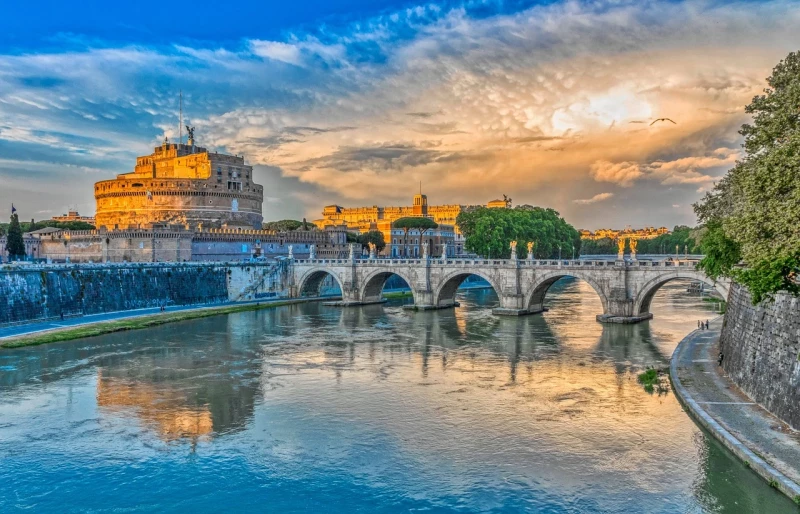
The Ponte Sant'Angelo and Castel Sant'Angelo: A Journey through History and Beauty
Ponte Sant'Angelo (Bridge of Angels):
-
Picturesque Views of the Tiber: Originally built by Emperor Hadrian in the 2nd century, Ponte Sant'Angelo provides picturesque views of the Tiber River. The angel statues lining the bridge add an artistic dimension.
-
Romantic Atmosphere: In the evening, the bridge is illuminated, creating a romantic atmosphere. It's the perfect place for a tranquil stroll with a view of the city.
Castel Sant'Angelo (Castle of the Holy Angel):
-
Former Imperial Mausoleum: Also constructed by Hadrian, Castel Sant'Angelo served as an imperial mausoleum before evolving into a fortress over the centuries.
-
Impressive Architecture: The castle's architecture, with its imposing ramparts and the statue of the Archangel Michael crowning its top, bears witness to its rich history.
-
Cultural Exhibitions: Today, Castel Sant'Angelo hosts cultural exhibitions and offers a panoramic view of Rome from its terrace.
Visiting Ponte Sant'Angelo and Castel Sant'Angelo is an immersion into the history of Rome, combining architectural grandeur with panoramic views and a romantic ambiance.
 Our tips for getting the most out of your experience.
Our tips for getting the most out of your experience.
Tips for Visiting Ponte Sant'Angelo and Castel Sant'Angelo:
-
Combine Day and Night Explorations: Explore Ponte Sant'Angelo and Castel Sant'Angelo during both day and night. The changing views and atmosphere provide a comprehensive experience.
-
Catch the Sunset on the Bridge: Witness the sunset from Ponte Sant'Angelo. The warm colors of the setting sun create a magical backdrop over the Tiber River.
-
Capture the Angel Statues: The angel statues lining Ponte Sant'Angelo are not only symbolic but also visually striking. Capture their beauty, especially during the golden hour.
-
Ascend to the Castle's Terraces: Climb to the terraces of Castel Sant'Angelo for panoramic views of Rome. The scenery is particularly breathtaking during the evening when the city lights up.
-
Check for Cultural Events: Prior to your visit, check if there are any cultural events or exhibitions taking place at Castel Sant'Angelo. It could add an extra layer to your experience.
-
Learn the Historical Significance: Familiarize yourself with the historical significance of both the bridge and the castle. Knowing the stories behind them enhances your overall appreciation.
-
Visit During Off-Peak Hours: Plan your visits during off-peak hours, especially early morning or late evening, to avoid crowds and enjoy a more relaxed exploration.
-
Consider a Guided Tour: A guided tour can provide insightful details about the history and architecture of Ponte Sant'Angelo and Castel Sant'Angelo, enriching your visit.
-
Enjoy a Riverside Stroll: After exploring the bridge and castle, take a leisurely stroll along the banks of the Tiber River for a different perspective of the surroundings.
-
Café Break Nearby: Find a nearby café or gelateria near Ponte Sant'Angelo or Castel Sant'Angelo to relax, enjoy some refreshments, and soak in the atmosphere.
By incorporating these tips, your visit to Ponte Sant'Angelo and Castel Sant'Angelo will not only be visually rewarding but also offer a deeper understanding of their historical and cultural significance.
12 - Villa Borghese
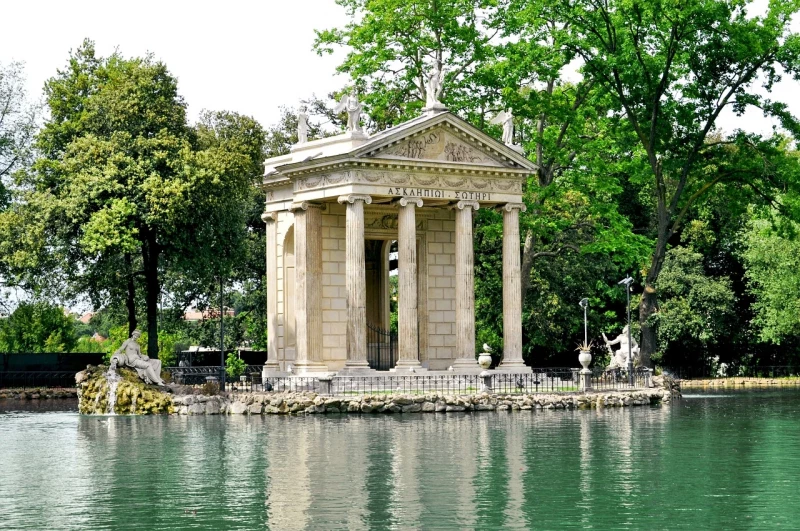
The Villa Borghese in Rome is an artistic and natural oasis, providing a peaceful escape within the bustling city. Here is a description of this iconic destination for a travel theme:
Villa Borghese: A Garden of Art and Serenity
-
Majestic Gardens: Villa Borghese is surrounded by extensive lush gardens. Explore shaded pathways, refreshing fountains, and artistic sculptures that punctuate the green landscape.
-
The Borghese Gallery: Inside the villa, the Borghese Gallery houses an impressive collection of artworks, including sculptures by Bernini and paintings by Caravaggio. Each room is an immersion in artistic splendor.
-
The Lake and the Temple of Aesculapius: At the far end of the gardens, discover the picturesque lake where you can rent rowboats. Near the lake is the Temple of Aesculapius, adding a touch of mystique to the surroundings.
-
The Pincian Hill (Il Pincio): Climb up to the Pincian Hill, a panoramic terrace offering breathtaking views of the city. It's an ideal spot for a peaceful break and to admire the sunset over Rome.
-
The Outdoor Theater (Teatro di Verdura): The open-air theater often hosts performances and cultural events. Check the local calendar to see if there are any shows during your visit.
Villa Borghese offers an artistic and natural getaway, perfect for those seeking beauty, tranquility, and inspiration in the heart of Rome.
 Our tips for getting the most out of your experience.
Our tips for getting the most out of your experience.
Tips for Visiting Villa Borghese:
-
Book Tickets in Advance: To explore the Borghese Gallery, it's recommended to book your tickets in advance, as entry is timed and the number of visitors is limited.
-
Arrive Early in the Day: Start your visit early in the morning to avoid crowds and make the most of the serene atmosphere in the gardens.
-
Enjoy a Leisurely Stroll: Take your time exploring the vast gardens. Enjoy leisurely strolls along the shaded pathways, discovering sculptures and enjoying the natural beauty.
-
Picnic in the Gardens: Bring a picnic or grab some local snacks and relax in the gardens. There are designated areas where you can enjoy a meal amidst the greenery.
-
Explore the Borghese Gallery Room by Room: Inside the Borghese Gallery, explore each room at a comfortable pace. Take in the details of sculptures by Bernini and artworks by Caravaggio without feeling rushed.
-
Rent a Rowboat on the Lake: If weather permits, consider renting a rowboat on the lake. It's a delightful and romantic way to experience Villa Borghese from a different perspective.
-
Climb the Pincian Hill for Sunset: Climb up to the Pincian Hill in the late afternoon for a breathtaking view of the sunset over Rome. It's a magical experience.
-
Check for Special Events: Look out for special events, exhibitions, or performances happening in the gardens. These events can enhance your visit with cultural experiences.
-
Visit the Temple of Aesculapius: Explore the Temple of Aesculapius near the lake. It's a picturesque spot and adds a touch of ancient charm to your visit.
-
Use Bicycles for Exploration: Rent bicycles to cover more ground and explore different corners of Villa Borghese. It's an efficient way to see the extensive gardens.
-
Take Advantage of Audio Guides: If available, consider using audio guides in the Borghese Gallery. They provide insightful commentary and enhance your understanding of the artworks.
By following these tips, your visit to Villa Borghese will be a delightful blend of art, nature, and relaxation, offering a memorable experience in the heart of Rome.
13 - The Palatine Hill
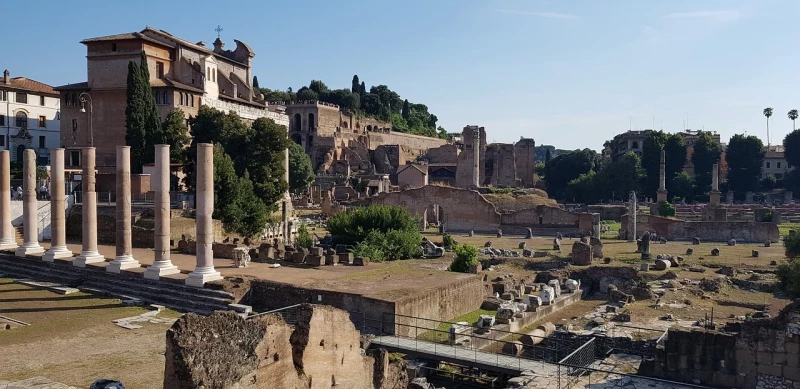
The Palatine Hill: A Journey through Rome's History
Located at the heart of the eternal city, the Palatine Hill offers a captivating exploration of Rome's history, from its legendary origins to its imperial zenith. Here's a description for a travel theme:
-
Mythical Origins: The Palatine Hill is the legendary birthplace of Rome according to Roman mythology. Explore the remains of the Hut of Romulus, echoing the city's humble beginnings.
-
Imperial Residences: Wander through the ruins of luxurious imperial residences lining the Palatine Hill. Imagine the sumptuous life of Roman emperors with breathtaking views of the Roman Forum and the Colosseum.
-
Farnese Gardens: Discover the Farnese Gardens, a green oasis atop the hill. Enjoy a peaceful stroll amidst groves and statues, providing a tranquil escape in the heart of the bustling city.
-
Panoramic Views of Rome: From the heights of the Palatine Hill, admire a stunning panoramic view of Rome's key historical sites, including the Roman Forum, Circus Maximus, and the Capitoline Hill.
-
Archaeology in Action: With ongoing archaeological excavations, witness archaeologists working on new discoveries that continually enrich our understanding of ancient Rome.
Visiting the Palatine Hill is an immersive dive into Rome's fascinating history, intertwining foundational myths, imperial splendor, and unforgettable panoramic views.
 Our tips for getting the most out of your experience.
Our tips for getting the most out of your experience.
Tips for Visiting the Palatine Hill:
-
Combined Tickets: Opt for combined tickets that include access to the Palatine Hill, Roman Forum, and Colosseum. This provides a comprehensive experience of Rome's historical sites.
-
Morning Visit: Plan your visit early in the morning to avoid crowds and enjoy a more peaceful atmosphere on the Palatine Hill. Morning light also provides ideal conditions for photography.
-
Audio Guide or Guided Tour: Use an audio guide or join a guided tour to gain in-depth information about the history and details of the archaeological sites.
-
Explore the Imperial Residences: Take time to explore the ruins of the imperial residences on the Palatine Hill. Imagine the daily life of Roman emperors amidst these grand remains.
-
Quiet Moment in the Farnese Gardens: Enjoy a quiet moment in the Farnese Gardens. It's an ideal spot to relax, rejuvenate, and appreciate the serenity amid history.
-
Panoramic View: Climb to the top of the Palatine Hill for an unforgettable panoramic view of the Roman Forum, Circus Maximus, and other iconic sites in Rome. It's particularly impressive at sunset.
-
Capture Twilight Moments: If possible, stay on the Palatine Hill until twilight. The warm colors of twilight add a magical touch to the atmosphere, creating exceptional photography opportunities.
-
Stay Informed about Ongoing Archaeological Discoveries: Stay informed about ongoing archaeological discoveries on the Palatine Hill. Information panels can give you insights into the current excavations.
-
Hydration and Sun Protection: Bring water and ensure you have sun protection, especially during the warm months. The Palatine Hill can be exposed to the sun, and it's essential to stay hydrated.
-
Respect History and the Environment: Be respectful of the archaeological sites. Avoid touching the ruins and follow guidelines to preserve this exceptional heritage.
By following these tips, your visit to the Palatine Hill will not only be educational but also immersive in the fascinating history of Rome. Enjoy every moment at the heart of this hill rich in legends and history.
Rome - Where to Stay?
In Rome, the choice of where to stay depends on your preferences, budget, and the kind of experience you're seeking. Here are some popular neighborhoods for lodging in Rome:
-
Historic Center (Centro Storico): This area includes iconic sites like the Pantheon, Trevi Fountain, and Piazza Navona. It's ideal if you want to be at the heart of history and within walking distance of major attractions.
-
Trastevere: A picturesque and bohemian neighborhood across the Tiber, Trastevere offers an authentic atmosphere with its cobblestone streets, local restaurants, and lively bars. It's an excellent choice for those seeking a more local experience.
-
Monti: A trendy and fashionable district, Monti is known for its vintage shops, trendy restaurants, and artistic vibe. It's also close to the Colosseum and Roman Forum.
-
Testaccio: This neighborhood is appreciated for its gastronomic scene, food markets, and laid-back atmosphere. It's a good choice for those who love authentic Italian cuisine.
-
Vatican: If you want to be close to the Vatican with St. Peter's Basilica and the Vatican Museums, look for accommodation in this area. You'll also be within walking distance of St. Peter's Square.
-
Esquilino: Near Termini Station, Esquilino is a cosmopolitan area offering a variety of international cuisines. It's a convenient choice if you're using the train for your travels.
-
Parioli: For a more residential and peaceful experience, Parioli offers green parks, elegant shops, and a chic atmosphere.
Ensure to book in advance, especially during the high tourist season, to secure the best rates and availability. Explore online reviews to find accommodation that best suits your needs and travel style.
Rome - How to get around?
In Rome, there are several transportation options for getting around the city. Here are some ways to move around Rome:
-
Walking: Rome's historic center is relatively compact, making it a pleasant city to explore on foot. This allows you to discover picturesque alleyways and historic sites in detail.
-
Public Transportation: Rome has an extensive public transportation network, including metros, buses, and trams. The metro is particularly useful for quickly moving from one point to another within the city. Buses and trams also cover the entire city.
-
Bike Rentals: Bike rentals are becoming increasingly popular in Rome, with many companies offering rental services. It's an excellent way to explore the city in an eco-friendly manner, especially on the numerous cycling paths available.
-
Scooter Rentals: For a faster and more flexible option, some people choose to rent scooters. However, this requires some experience in driving and knowledge of local traffic rules.
-
Taxis: Taxis are available throughout the city. Make sure to use official taxis to avoid any issues. You can hail them on the street or find them at designated taxi stands.
-
Ride-Sharing Apps: Ride-sharing services like Uber are also available in Rome, providing an alternative to traditional taxis.
-
Walking Tours or Hop-On Hop-Off Buses: For a more organized tourist experience, you can opt for guided walking tours or hop-on-hop-off buses that take you to the main city sights.
Since Rome is a city with numerous historical and tourist sites, most attractions are within walking distance of each other. This makes walking and using public transportation very convenient for exploring the city.
Rome - Best period
Visiting Rome, the capital of Italy, is a delightful experience with its rich history, art, and culture. The best time to visit Rome depends on your preferences regarding climate, tourist crowds, and special events. Here's an overview of the seasons in Rome:
-
Spring (March to May): Spring is generally considered one of the best times to visit Rome. Temperatures are pleasant, gardens and parks are in bloom, and there are fewer crowds compared to the summer. It's an ideal time for exploring historical sites and enjoying outdoor life.
-
Summer (June to August): Summer in Rome can be hot, with temperatures often reaching high levels. It is also the peak tourist season, with significant crowds. If visiting during the summer, it's advisable to plan your visits early in the morning or late in the afternoon to avoid the heat and crowds.
-
Autumn (September to November): Autumn is another pleasant time to visit Rome. Temperatures are mild, and there are generally fewer visitors than in the summer. It's a great time to appreciate local cuisine and participate in cultural events.
-
Winter (December to February): Winter in Rome is mild compared to more northern regions, but there can be cooler days. Tourist sites are less crowded, and it can be enjoyable to explore the city without the summer crowds.
In summary, spring and autumn are generally considered the best seasons to visit Rome due to pleasant temperatures and fewer crowds compared to summer. However, each season has its unique charms, so choose the one that aligns best with your preferences.
